Superannuation funds were looking to offer reverse mortgages as retirees increasingly used this product to provide an income stream, Deloitte banking partner James Hickey said yesterday.
Hickey said some industry superannuation funds in particular were looking to “white-label” reverse mortgages (RM).
Some aged-care providers were “talking with providers of reverse mortgages to custom-fit products”, he said at the launch of Deloitte’s 10th study of the Australian reverse mortgage sector.
While more retirees were looking at reverse mortgages, settlements had not returned to the peak years of 2006 and 2007, he added.
The survey, commissioned by the Senior Australians Equity Release Association (SEQUAL), showed 10 per cent growth on the previous survey, with more than 42,000 RMs having total outstanding funding of $3.3 billion.
SEQUAL chairman John Thomas called on the federal government to support non-bank lenders, such as credit unions, because this lack of guarantee was constraining the sector’s growth after the global financial crisis (GFC).
Thomas said there were also suggestions the government itself should provide some form of reverse mortgage to help people to fund aged-care bonds.
Before the GFC, more than 20 RM lenders had been in the market. Now, there were just two major banks – Commonwealth Bank of Australia and Westpac Banking Corporation – and “a couple of non-bank lenders, but they are more restricted by their funds”, he said.
“In all, there are five members that are active now, and nine passive,” Thomas said.
Financial advisers were also actively looking to provide reverse mortgages, Hickey said.
“Pre-GFC, 23 of the top 25 financial planning groups had approved reverse mortgages on their approved product lists,” he said.
Most reverse mortgages were written directly with a bank (74 per cent), compared with planners and brokers at 26 per cent.
Despite this – and even though financial planners “are not accredited to write the loans” – Hickey said planners and mortgage brokers wrote an average settlement size of $79,750, compared with bank-direct sales of $54,000.
Both Hickey and Thomas agreed that one of the reasons reverse mortgages were returning to product offerings was that the RM income stream was classed as a return on capital and not as income if the RM income was used within 90 days of receipt.
Half of RM customers were couples between 70 to 75 years old who used the released equity for home improvements (18 per cent), to repay debts (16 per cent) and supplement income (15 per cent).
Hickey, who led the study, said 5000 new borrowers had accessed the equity in their homes in 2011. Total approved facilities were $426 million, with settlements of $317 million, a drawdown rate of 74 per cent, with the volume of new lending steady over the past two years.
This compared with the pre-GFC heyday of 2006 when total approved facilities were $714 million, with settlements of $520 million – a drawdown rate of 73 per cent.







